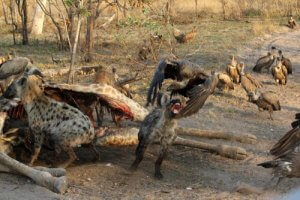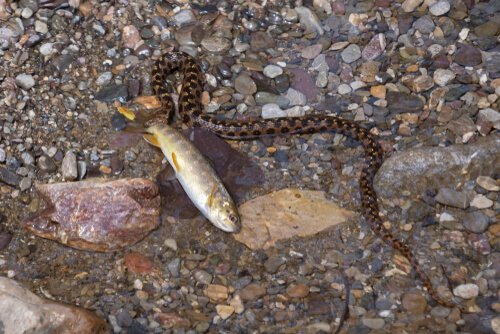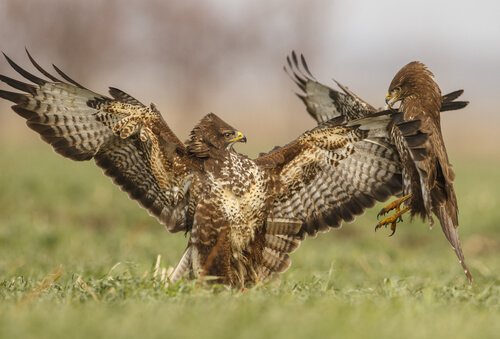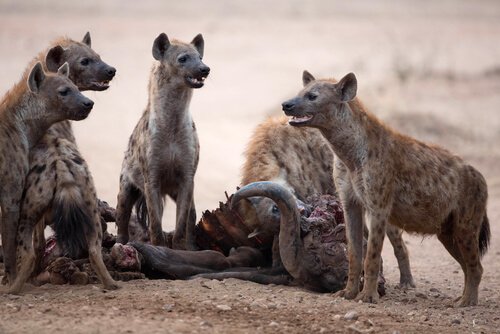Examples of Kleptoparasitism and Other Interesting Facts

Before we can give you some examples of kleptoparasitism, you’re probably wondering what it is. It’s defined as ‘the theft of prey or other food that was previously captured by another individual.”
Scientists also call it ‘food parasitism”. The concept was introduced to define theft that occurred between individuals of different species, so it was called interspecific kleptoparasitism.
However, it’s currently used to define the action of individuals of the same species, which is called intraspecific kleptoparasitism. The kleptoparasite is the one that steals, while the host is the one that is stolen from.
Rothschild and Clay first introduced the concept in 1952. Today, scientists recognize it as a food strategy that allows the animal to gain limited resources. In 1979, Brockmann and Barnard differentiated the two groups:
- Specialists. They have a series of morphological adaptations. For example, the ability to increase the speed of their flight as well as their maneuverability. Additionally, most of the food they obtain is through this practice. It’s interspecific kleptoparasitism.
- Opportunists. Those that only steal food at certain times, like when they can see it in the host’s beak. These animals carry out this practice both in an intraspecific and interspecific way.
There are different studies that collect information about this curious practice among species. This concept doesn’t just refer to the theft of food, but also to the theft of materials, the construction of nests, etc.
The bibliography has focused on the study of ecological interaction between birds, specifically seabirds. However, there are also some cases of kleptoparasitism in different groups of animals, both vertebrates and invertebrates.
Factors that influence kleptoparasitism
Among the factors that may affect this strategy are:
- Environmental conditions
- The number of potential hosts in relation to the number of kleptoparasites
- The size of the kleptoparasite with respect to the host
- Tactic used by the kleptoparasite
- Nutritional quality of the prey
Examples of kleptoparasitism
Water snake or viperine (Natrix maura)
The viperine snake lives in the Western Mediterranean, including the Iberian Peninsula, where there is a large population of them. Their diet is mainly based around fish and amphibians.

However, scientists have recently observed these snakes practicing intraspecific kleptoparasitism. This is the theft of prey of an individual of a species by another individual of the same species.
The funny thing is that kleptoparasitism had only previously been studied in some species of reptiles, but never the Natrix maura. Apparently, this technique is typical in regions that are densely populated with them, and where they can’t find prey as easily.
Canarian buzzards (Buteo buteo)
The Canarian buzzard belongs to the Buteo buteo species. These birds participate in two types of kleptoparasitism. On one hand, larger birds of prey force these buzzards to give them their food. But, on the other hand, they also take food from smaller birds.

Recently, a group of scientists observed this practice on the island of Tenerife in Spain. Kleptoparasitism has an opportunistic character among buzzards. Before encountering an avian species, they’ll overpower it and take its prey.
Hyenas
Hyenas belong to the Hyaenidae species and is said to be one of the best examples of kleptoparasitism among mammals. These animals are mostly scavenger mammals, but they also practice kleptoparasitism when they have the opportunity.

This species only lives on the African continent due to several factors, like climate change and human action.
Interesting facts
Scientists have also observed this practice in invertebrates, including among arthropods. Within arthropods, a good example are spiders, which was shown in the study of the Argyrodes elevatus species.
Apparently, this spider practiced kleptoparasitism as a way to court another spider. That means they used it like a nuptial gift. The male stole a prey from within the community network of his host, Metepeira incrassat. Then, he gave the prey to the female spider and, while she fed on it, the male copulated with her. This is the first recorded case of kleptoparasitism in Argyrodes elevatus with the purpose of a nuptial gift.
Kleptoparasitism is a little known, but very interesting strategy. Animals adopt behavior that allows them to survive and evolve, even at the expense of other individuals. There are many other interesting behavior patterns that animals exhibit, like coprophagy.
Before we can give you some examples of kleptoparasitism, you’re probably wondering what it is. It’s defined as ‘the theft of prey or other food that was previously captured by another individual.”
Scientists also call it ‘food parasitism”. The concept was introduced to define theft that occurred between individuals of different species, so it was called interspecific kleptoparasitism.
However, it’s currently used to define the action of individuals of the same species, which is called intraspecific kleptoparasitism. The kleptoparasite is the one that steals, while the host is the one that is stolen from.
Rothschild and Clay first introduced the concept in 1952. Today, scientists recognize it as a food strategy that allows the animal to gain limited resources. In 1979, Brockmann and Barnard differentiated the two groups:
- Specialists. They have a series of morphological adaptations. For example, the ability to increase the speed of their flight as well as their maneuverability. Additionally, most of the food they obtain is through this practice. It’s interspecific kleptoparasitism.
- Opportunists. Those that only steal food at certain times, like when they can see it in the host’s beak. These animals carry out this practice both in an intraspecific and interspecific way.
There are different studies that collect information about this curious practice among species. This concept doesn’t just refer to the theft of food, but also to the theft of materials, the construction of nests, etc.
The bibliography has focused on the study of ecological interaction between birds, specifically seabirds. However, there are also some cases of kleptoparasitism in different groups of animals, both vertebrates and invertebrates.
Factors that influence kleptoparasitism
Among the factors that may affect this strategy are:
- Environmental conditions
- The number of potential hosts in relation to the number of kleptoparasites
- The size of the kleptoparasite with respect to the host
- Tactic used by the kleptoparasite
- Nutritional quality of the prey
Examples of kleptoparasitism
Water snake or viperine (Natrix maura)
The viperine snake lives in the Western Mediterranean, including the Iberian Peninsula, where there is a large population of them. Their diet is mainly based around fish and amphibians.

However, scientists have recently observed these snakes practicing intraspecific kleptoparasitism. This is the theft of prey of an individual of a species by another individual of the same species.
The funny thing is that kleptoparasitism had only previously been studied in some species of reptiles, but never the Natrix maura. Apparently, this technique is typical in regions that are densely populated with them, and where they can’t find prey as easily.
Canarian buzzards (Buteo buteo)
The Canarian buzzard belongs to the Buteo buteo species. These birds participate in two types of kleptoparasitism. On one hand, larger birds of prey force these buzzards to give them their food. But, on the other hand, they also take food from smaller birds.

Recently, a group of scientists observed this practice on the island of Tenerife in Spain. Kleptoparasitism has an opportunistic character among buzzards. Before encountering an avian species, they’ll overpower it and take its prey.
Hyenas
Hyenas belong to the Hyaenidae species and is said to be one of the best examples of kleptoparasitism among mammals. These animals are mostly scavenger mammals, but they also practice kleptoparasitism when they have the opportunity.

This species only lives on the African continent due to several factors, like climate change and human action.
Interesting facts
Scientists have also observed this practice in invertebrates, including among arthropods. Within arthropods, a good example are spiders, which was shown in the study of the Argyrodes elevatus species.
Apparently, this spider practiced kleptoparasitism as a way to court another spider. That means they used it like a nuptial gift. The male stole a prey from within the community network of his host, Metepeira incrassat. Then, he gave the prey to the female spider and, while she fed on it, the male copulated with her. This is the first recorded case of kleptoparasitism in Argyrodes elevatus with the purpose of a nuptial gift.
Kleptoparasitism is a little known, but very interesting strategy. Animals adopt behavior that allows them to survive and evolve, even at the expense of other individuals. There are many other interesting behavior patterns that animals exhibit, like coprophagy.
All cited sources were thoroughly reviewed by our team to ensure their quality, reliability, currency, and validity. The bibliography of this article was considered reliable and of academic or scientific accuracy.
- Escrivà-Colomar, I., & Rodríguez-Rodríguez, E. J. (2016). Un caso de cleptoparasitismo intraespecífico en Natrix maura. Boletín de La Asociación Herpetológica Española, 27(1), 2015–2017.
- Scientific, N. (2017). Cleptoparasitismo en aves como una estrategia trófica oportunista: costos y beneficios para parásitos y hospedadores., (December 2010). https://doi.org/10.13140/RG.2.2.16748.26246
- Siverio, F., Rodríguez, B., Rodríguez, A., & Siverio, M. (2017). Cleptoparasitismo en busardos ratoneros canarios. Quercus, 381(November), 12–14.
-
Carbone, C., Frame, L., Frame, G., Malcolm, J., Fanshawe, J., FitzGibbon, C., . . . Du Toit, J. (2005). Feeding success of African wild dogs (Lycaon pictus) in the Serengeti: The effects of group size and kleptoparasitism. Journal of Zoology, 266(2), 153-161. doi:10.1017/S0952836905006710
This text is provided for informational purposes only and does not replace consultation with a professional. If in doubt, consult your specialist.








